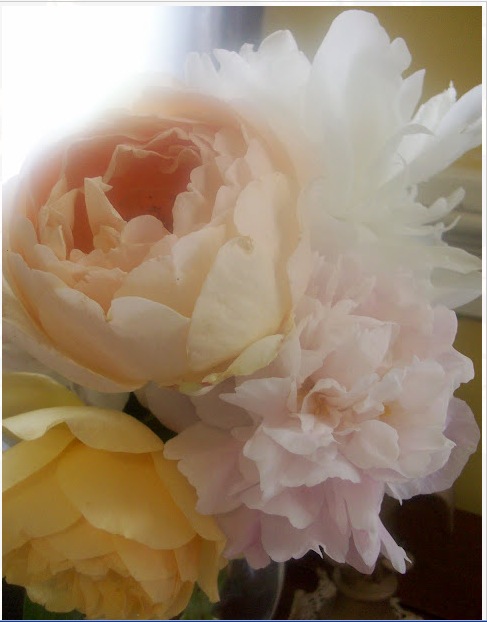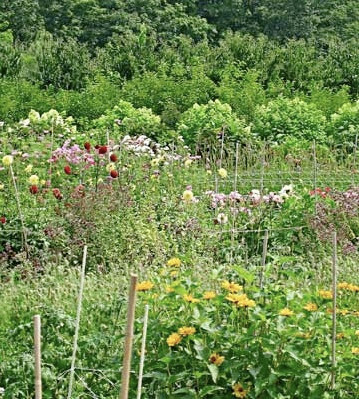Cutting Gardens and Flower Arranging
You’ve determined your space and size – so what flowers do you include in your cutting garden. Planting flowers by seed allows a wide variety of plant type and color. Some flowers need to be purchased as seedlings. Roses and flowering bulbs are additional resources for the cutting garden – some bulbs can be planted closely together requiring little space. Some to consider include: Cosmos, gladiolus, daffodils, marigold, salvia, dahlias, verbena, zinnia, tithonia, scabiosa, delphinium, sunflowers, gomphrena, strawflowers, statice, phlox, ageratum, snapdragons, rudbekia, celosia, monarda and so forth.
Once you’ve grown and cut your flowers arranging is the fun part. Here are a few tips in flower arranging.
- Conditioning your cut flowers. Timing is very important here. Since the flowers are still living once cut they require two things – food and water.
- Cutting flowers early in the morning or after sunset are the best times to cut. The flowers have recovered themselves from the affects of the sun of the day and at the end of the day are fully nourished.
- Choosing buds that are just beginning to open allow for arrangements with longer lasting blooms.
- As you cut the flowers it is also best to carry around a bucket with ‘tepid water’. This allows water to be more readily and quickly absorbed by the flower. If you allow the flower to set out while cutting the cut end will begin to seal – to heal cutting off access to water. Once you’ve cut all your flowers and brought them indoors – cut each stem once again – I like to cut under running water and place them immediately into a fresh bucket of water. Martha Stewart suggests cutting the stem at a 45 degree angle allowing ‘greater surface area’ for water absorption. Also remove any leaf that could fall below the waterline – leaves under water will rot causing bacteria to form in the water.
- You now add flower food or some sugar – naturally flowers synthesize sunshine converting the nutrient into glucose. Now allow the flowers to drink in the water and rest over night. Establishing beautiful, long-lasting arrangements requires some patience and planning. This is not to say you can’t pick flowers for a special occasion that very day – just realize the arrangement won’t last as long. This resting period allows the cut flowers to ‘harden’ a process florists recognize that while the flowers are absorbing the water they’re ‘becoming stronger, stiffer and more ready to withstand flower arranging’.
Some flowers require special treatment for long lasting arrangements.
- For Lilacs – place the cut stem in wood alcohol for an hour (available at hardware stores) then place in cold water and leave in a cool area overnight. According to Martha Stewart – never place Lilacs in a metal container – ‘they will wilt’.
- Daffodils are also to be treated differently. Because when cut they ‘release a substance that is harmful to other floers, daffodils and hyacinths should be conditioned separately for twenty-four hours before combining with other flowers’.
- Marigold’s strong fragrance can be neutralized by adding one tablespoon of sugar into the water in your selected vase.
- Euphorbias need to also be placed separately to prevent yellowing and mildew from building up.
- Amaryllis are notorious for having their stems to split and to curl – cutting them frequently or short initially is the best solution.
- Poppies, Euphorbias, Hollyhocks, Zinnias and Sunflowers exude milky substances from their stems. To condition these flowers, dip the end in boiling water for thirty seconds or sear the ends with the flame from a match. These flowers can draw water from the sides of their stems.
- Woody Stemmed flowers like – dogwood, azalea, camellias, forsythia, crabapples and lilacs should have their stems split vertically about an inch at the bottom to allow water to be absorbed. If the stem is quite thick you can smash the end to allow water absorption.
- Flowers with hollow stems require a lot of water. A tip is to fill the stems with water cover the end with your finger or absorbent cotton ball and place in water –
- When cutting flowers grown from bulbs be sure to cut off the thick quite end to allow for the flower to draw water up its stem.
 |
| Wisteria and Azalea |
 |
| Iris and Forsythia |
More tips (from Martha Stewart Arranging Flowers)
- The pollen from Lilies can stain your clothing and furniture – removing the stamen prior to including these flowers in an arrangement will prevent this.
- When conditioning flowers such as sweet william, carnations, and baby’s breath make your cut on the stem just above one of the nodes on the stem.
- Carefully remove the thorns from the stems of your roses by working from top to bottom with a sharp knife or by using a stem stripper taking care not to damage the stem.
- If your roses look limp place them completely in a ‘bath of cool water’ with a paper towel covering them to allow them to absorb water throughout their pores.
- To keep tulips from drooping during their conditioning phase wrap them in brown paper or newspaper closely together and secure with twine or rubber band then place them in the water to condition overnight. Another trick for tulips if they appear to wilt and droop, pierce the stem just beneath the flower with a straight pen this allows air to escape and also allows for the water to flow better to the bloom.
Arranging flowers has changed over time – there are so very many ways – a dome, free flowing arrangements – or even a single bloom – the use of ordinary objects as vases is also quite popular – use your imagination. Growing your own flowers and a few careful steps before arranging can produce a bounty of arrangements delight you and to fill each room of your home. You can find these tips and much more inspiration in Martha Stewart’s book, ‘Arranging Flowers – How to Create Beautiful Bouquets in Every Season’.
Home and Garden Thursday










